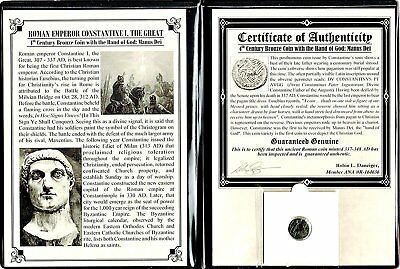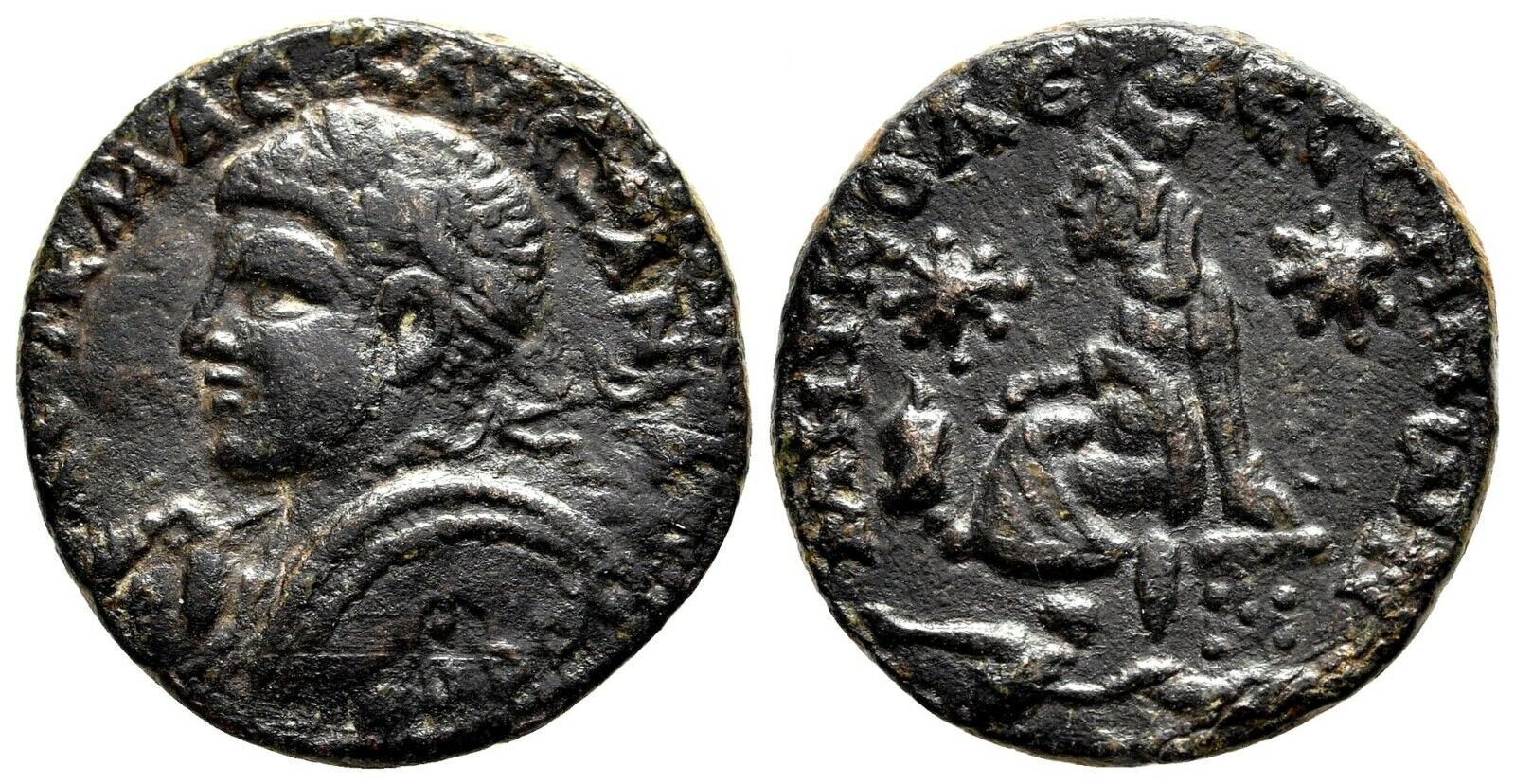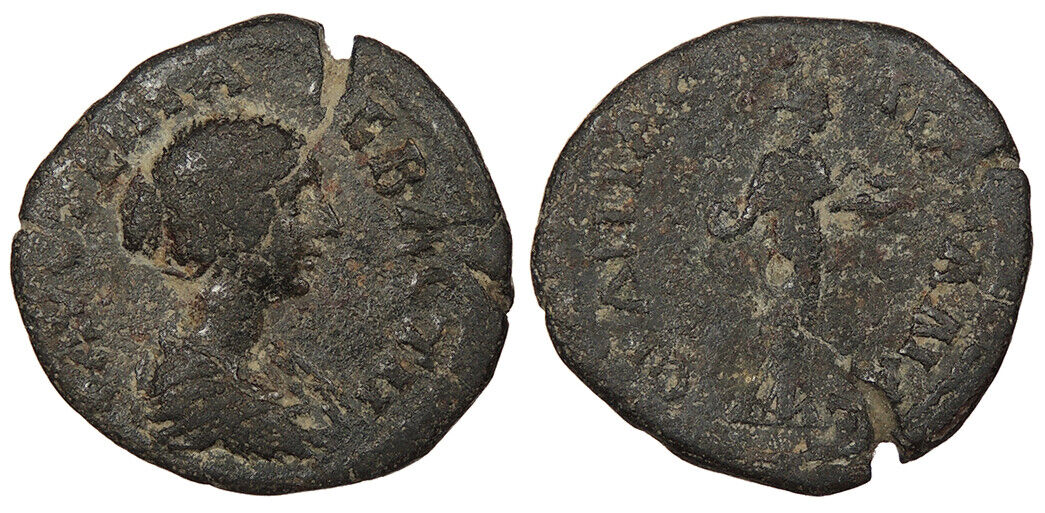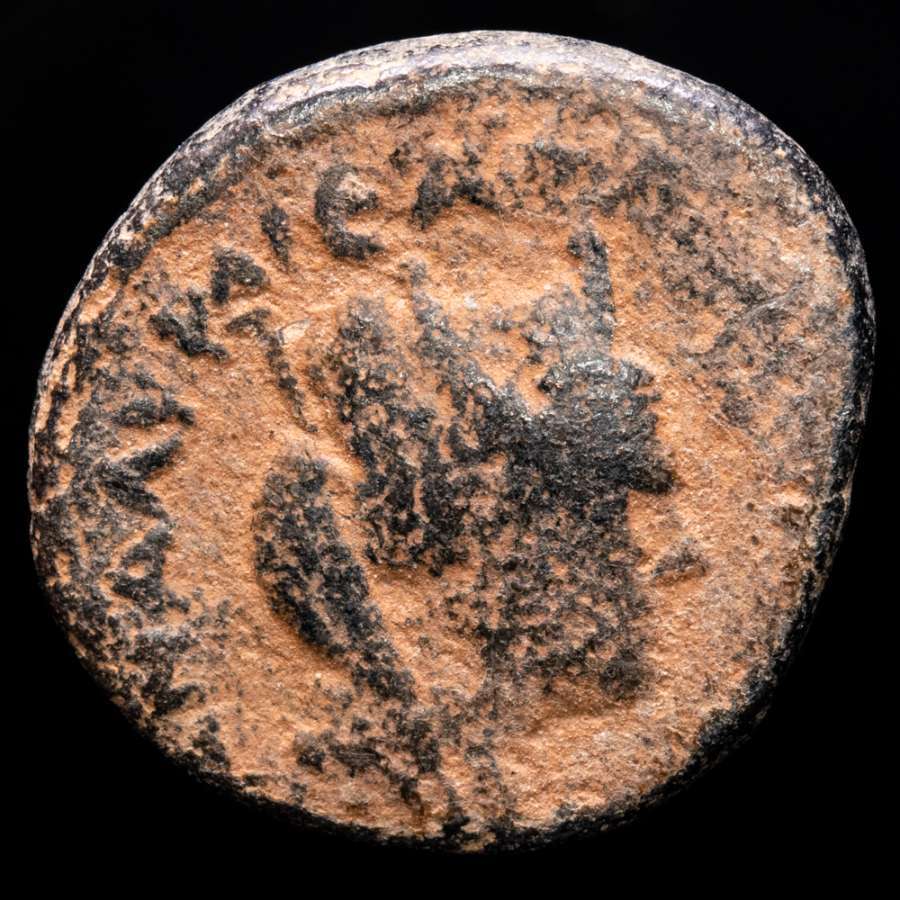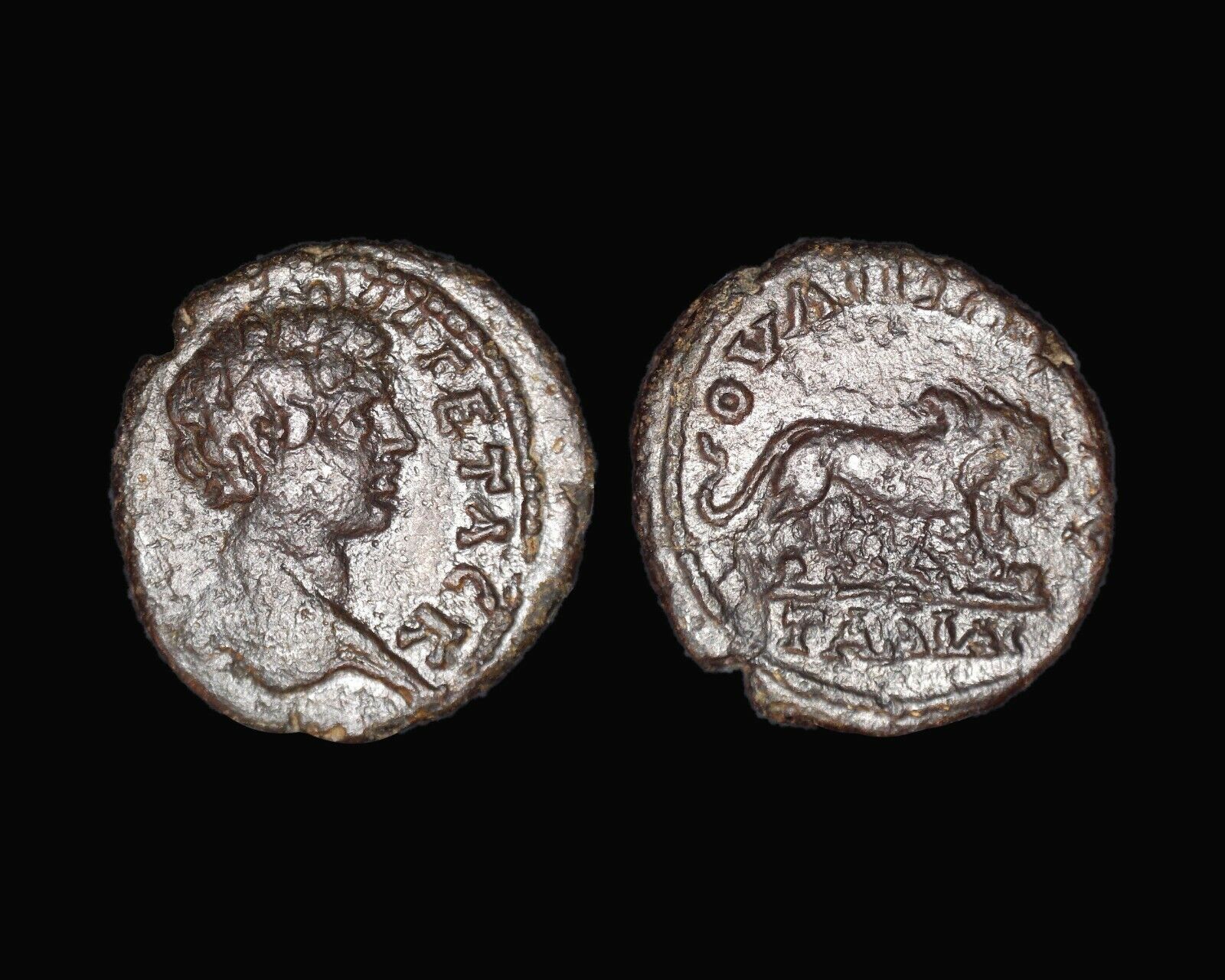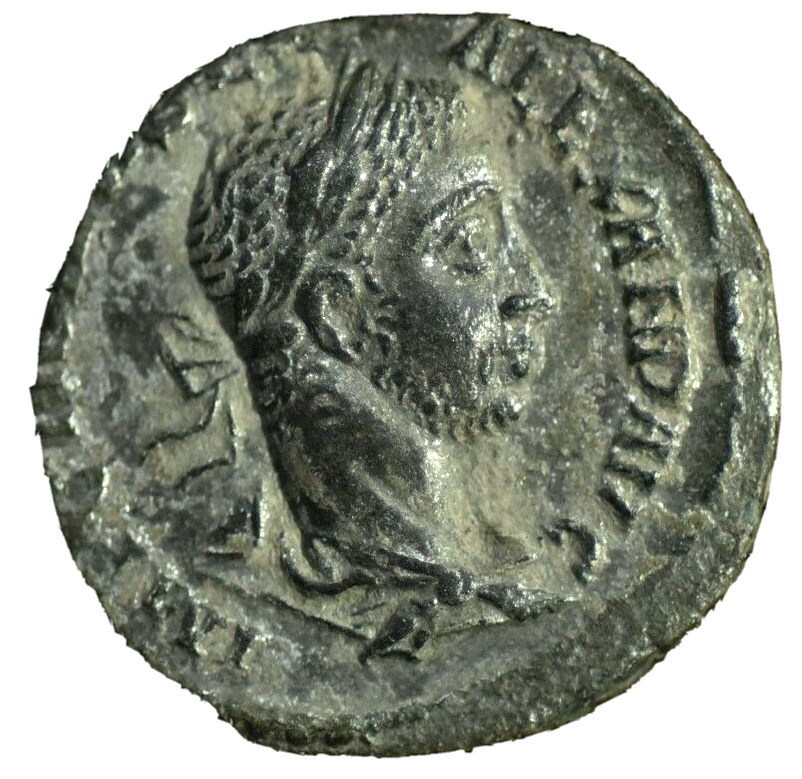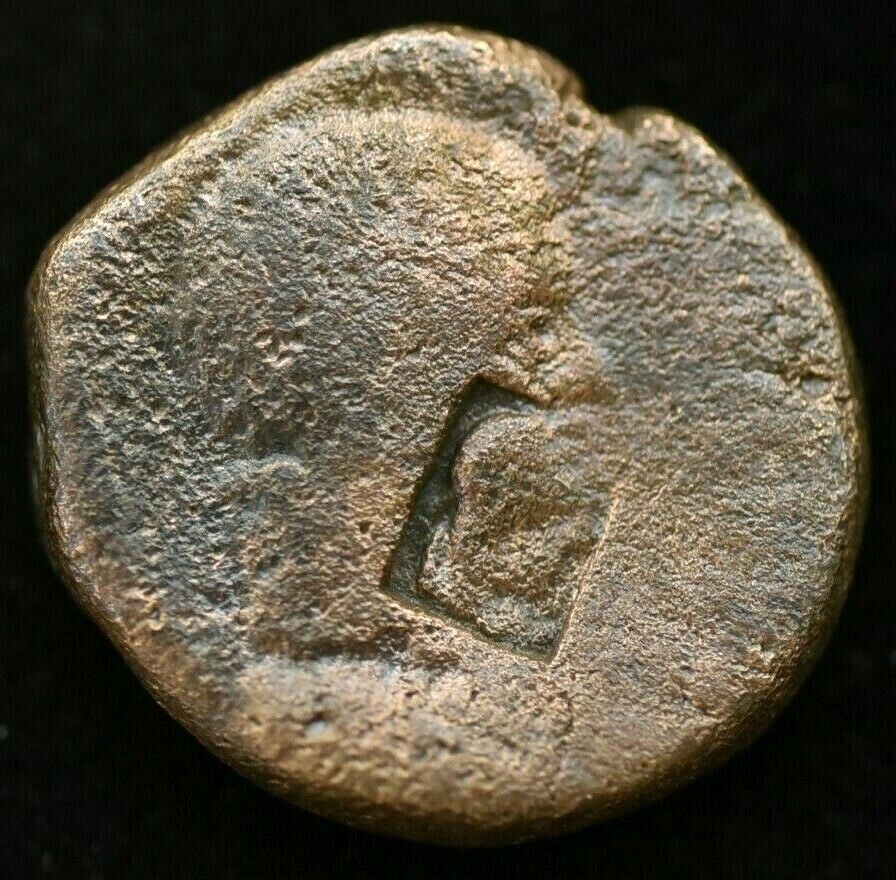-40%
MARCUS AMBIBULUS Augustus Jerusalem Ancient 8-11AD BIBLICAL Roman Coin i112985
$ 31.04
- Description
- Size Guide
Description
Item:i112985
Authentic Ancient Coin of:
Marcus Ambibulus
prefect of Judaea under Roman Emperor
Augustus
, ruling 9-12 A.D.
Bronze Prutah 15mm (1.18 grams) from the mint of
Jerusalem
8-11 A.D.
Reference:
Hendin
1329-1331 (5th Edition)
KAICAPOC (of Caesar), ear of grain curved to right
LΛΘ or LM or LMA (year 39/40/41 = 8-11 A.D.) in fields; eight-branched palm tree bearing two bunches of dates.
Marcus Ambibulus was Roman Prefect of the province of Judaea and Samaria. Originally a cavalry officer, he succeeded Coponius in 9 AD and ruled the area until 13 AD when he was succeeded by Annius Rufus. Josephus noted his tenure in Antiquities 18.31.
Roman Procurator coinage
were coins issued by the Roman Procurators and Prefects of the province of
Judaea
between 6 - 66 A.D. They minted only one denomination and size, the bronze prutah. Not all of the Procurators issued coinage. The procurators / prefects of the province of Judaea under the Romans that issued coins were
Coponius
,
Marcus Ambibulus
,
Valerius Gratus
,
Pontius Pilate
,
Antonius Felix
and
Porcius Festus
. The last three Procurators Lucceius Albinus, Gessius Florus and Marcus Antonius Julianus didn't issue any coins as the tidings of the First Jewish-Roman War was in the air brewing during emperor
Nero's
reign and the leaders of the revolt started issuing their own coins, for what is known as the
Jewish War
.
You are bidding on the exact item pictured, provided with a Certificate of Authenticity and Lifetime Guarantee of Authenticity.
Judea
(Hebrew: יהודה, Standard
Yehuda
Tiberian
Yehûḏāh
; Arabic: يهودا; Greek: Ἰουδαία; Latin:
IVDAEA
), sometimes spelled in its original Latin forms of
Judæa
,
Judaea
or
Iudaea
to distinguish it from the geographical region of Judea, was a Roman province that incorporated the geographical regions of Judea, Samaria, and Idumea, and which extended over parts of the former regions of the Hasmonean and Herodian kingdoms of Israel. It was named after Herod Archelaus's Tetrarchy of Judea, of which it was an expansion, the latter name deriving from the Kingdom of Judah of the 6th century BCE.
Rome's involvement in the area dated from 63 BCE, following the end of the Third Mithridatic War, when Rome made Syria a province. In that year, after the defeat of Mithridates VI of Pontus, the proconsul Pompeius Magnus (Pompey the Great) sacked Jerusalem and entered the Jerusalem Temple. Subsequently, during the 1st century BCE, the Herodian Kingdom was established as a Roman client kingdom and then in 6 CE parts became a province of the Roman Empire.
Judea province was the scene of unrest at its founding during the Census of Quirinius and several wars were fought in its history, known as the Jewish-Roman wars. The Temple was destroyed in 70 as part of the Great Jewish Revolt resulting in the institution of the Fiscus Judaicus, and after Bar Kokhba's revolt (132-135 CE), the Roman Emperor Hadrian changed the name of the province to
Syria Palaestina
and Jerusalem to
Aelia Capitolina
, which certain scholars conclude was done in an attempt to remove the relationship of the Jewish people to the region.
Relations with Hasmonean and Herodian dynasties
The first intervention of Rome in the region dates from 63 BCE, following the end of the Third Mithridatic War, when Rome made a province of Syria. After the defeat of Mithridates VI of Pontus, Pompey (Pompey the Great) remained there to secure the area.
The region at the time was not a peaceful place. The Queen of Judaea Salome Alexandra had recently died and her sons, Hyrcanus II and Aristobulus II, divided against each other in a civil war.
In 63 BCE, Aristobulus was besieged in Jerusalem by his brother's armies. He sent an envoy to Marcus Aemilius Scaurus, Pompey's representative in the area. Aristobulus offered a massive bribe to be rescued, which Pompey promptly accepted. Afterwards, Aristobulus accused Scaurus of extortion. Since Scaurus was Pompey's brother in law and protégée, the general retaliated by putting Hyrcanus in charge of the kingdom as Ethnarch and High Priest, but he was denied the title of King.
When Pompey was defeated by Julius Caesar, Hyrcanus was succeeded by his courtier Antipater the Idumaean, also known as Antipas, as the first Roman Procurator. In 57-55 BCE, Aulus Gabinius, proconsul of Syria, split the former Hasmonean Kingdom of Israel into five districts of the Sanhedrin.
Both Caesar and Antipater were killed in 44 BCE, and the Idumean Herod the Great, Antipater's son, was designated "King of the Jews" by the Roman Senate in 40 BCE. He didn't gain military control until 37 BCE. During his reign the last representatives of the Maccabees were eliminated, and the great port of Caesarea Maritima was built. He died in 4 BCE, and his kingdom was divided among three of his sons, who became tetrarchs ("rulers of a quarter part", or in this case rather of "thirds"). One of these tetrarchies was
Judea
corresponding to the territory of the tribe of Judah, plus Samaria and Idumea. Herod's son Herod Archelaus, ruled Judea so badly that he was dismissed in 6 CE by the Roman emperor Augustus, after an appeal from his own population. Another, Herod Antipas, ruled as tetrarch of Galilee and Perea from 4 BCE to 39 CE, being then dismissed by Caligula. The third tetrarch, Herod's son Philip, ruled over the northwestern part of his father's kingdom.
Judea as Roman province
In 6 CE Judea became part of a larger Roman province, called
Iudaea
, which was formed by combining Judea proper (biblical Judah) with Samaria and Idumea (biblical Edom). Even though
Iudaea
is simply derived from the Latin for
Judea
, many historians use it to distinguish the Roman province from the previous territory and history. Iudaea province did not include Galilee, Gaulanitis (the Golan), nor Peraea or the Decapolis. Its revenue was of little importance to the Roman treasury, but it controlled the land and coastal sea routes to the bread basket Egypt and was a border province against the Parthian Empire because of the Jewish connections to Babylonia (since the Babylonian exile). The capital was at Caesarea, not Jerusalem, which had been the capital for King David, King Hezekiah, King Josiah, the Maccabees and Herod the Great. Quirinius became Legate (Governor) of Syria and conducted the first Roman tax census of Syria and Iudaea, which was opposed by the Zealots. Iudaea was not a Senatorial province, nor exactly an Imperial province, but instead was a "satellite of Syria" governed by a prefect who was a knight of the equestrian order (as was Roman Egypt), not a former consul or praetor of senatorial rank. Pontius Pilate was one of these prefects, from 26 to 36 CE. Caiaphas was one of the appointed High Priests of Herod's Temple, being appointed by the Prefect Valerius Gratus in 18. Both were deposed by the Syrian Legate Lucius Vitellius in 36 CE.
The 'Crisis under Caligula' (37-41) has been proposed as the first open break between Rome and the Jews.
Between 41 and 44 CE, Iudaea regained its nominal autonomy, when Herod Agrippa was made King of the Jews by the emperor Claudius, thus in a sense restoring the Herodian Dynasty, though there is no indication Iudaea ceased to be a Roman province simply because it no longer had a prefect. Claudius had decided to allow, across the empire, procurators, who had been personal agents to the Emperor often serving as provincial tax and finance ministers, to be elevated to governing magistrates with full state authority to keep the peace. He elevated Iudaeas's procurator whom he trusted to imperial governing status because the imperial legate of Syria was not sympathetic to the Judeans. Following Agrippa's death in 44 CE, the province returned to direct Roman control for a short period. Agrippa's son Marcus Julius Agrippa was designated King of the Jews in 48. He was the seventh and last of the Herodians. From 70 CE until 135 CE, Iudaea's rebelliousness required a governing Roman legate capable of commanding legions. Because Agrippa II maintained loyalty to the Empire, the Kingdom was retained until he died, either in 93/94 or 100, when the area returned to complete, undivided Roman Empire control.
Judaea was the stage of two, possibly three major rebellions against Roman rule:
66-70 CE - first rebellion, ending in the siege of Jerusalem and the destruction of Herod's Temple (see Great Jewish Revolt, Josephus)
115-117 CE - second rebellion, called Kitos War; Judaea's role in it is disputed though, as it played itself out mainly in the Jewish diaspora and there are no fully trustworthy sources on Judaea's participation in the rebellion, nor is there any archaeological way of distinguishing destruction levels of 117 CE from those of the large Bar Kokhba revolt of just a decade and a half later.
132-135 CE - third rebellion, Bar Kokhba's revolt
Following the suppression of Bar Kokhba's revolt, the emperor Hadrian changed the name of the province to
Syria Palaestina
and Jerusalem became
Aelia Capitolina
which Hayim Hillel Ben-Sasson states was done to erase the historical ties of the Jewish people to the region.
Under Diocletian (284-305) the region was divided into
Palaestina Prima
(Judea, Samaria, Idumea, Peraea and the coastal plain with Caesarea as capital),
Palaestina Secunda
(Galilee, Decapolis, Golan with Beth-shean as capital) and
Palaestina Tertia
(the Negev with Petra as capital).
Frequently Asked Questions
Mr. Ilya Zlobin
, world-renowned expert numismatist, enthusiast, author and dealer in authentic ancient Greek, ancient Roman, ancient Byzantine, world coins & more.
Who am I dealing with?
You are dealing with Ilya Zlobin, ancient coin expert, enthusiast, author and dealer with an online store having a selection of over 15,000 items with great positive feedback from verified buyers and over 10 years experience dealing with over 57,000 ancient and world coins and artifacts. Ilya Zlobin is an independent individual who has a passion for coin collecting, research and understanding the importance of the historical context and significance all coins and objects represent. Most others are only concerned with selling you, Ilya Zlobin is most interested in educating you on the subject, and providing the largest selection, most professional presentation and service for the best long-term value for collectors worldwide creating returning patrons sharing in the passion of ancient and world coin collecting for a lifetime.
How long until my order is shipped?
Orders are shipped by the next business day (after receipt of payment) most of the time.
How will I know when the order was shipped?
After your order has shipped, you will be left positive feedback, and that date could be used as a basis of estimating an arrival date. Any tracking number would be found under your 'Purchase history' tab.
USPS First Class mail takes about 3-5 business days to arrive in the U.S. International shipping times cannot be estimated as they vary from country to country.
Standard international mail to many countries
does not
include a tracking number, and can also be slow sometimes.
For a tracking number and signature confirmation, you may want to do Express Mail International Shipping, which costs more, however, is the fastest and most secure. Additionally you may be able to receive your order in as little as 3-5 business days using this method. For Express Mail International, it may be possible to place up to 10-15 items in one package (for the one shipping cost) as it is flat rate envelope, which may be the most cost-effective, secure and fastest way to receive items internationally. Send me a message about this and I can update your invoice should you want this method.
Getting your order to you, quickly and securely is a top priority and is taken seriously here.
Great care is taken in packaging and mailing every item securely and quickly.
Please be aware, I cannot take responsibility for any postal service delivery delays, especially for international packages as it may happen in rare instances.
What is a certificate of authenticity and what guarantees do you give that the item is authentic?
Each of the items sold here, is provided with a Certificate of Authenticity, and a Lifetime Guarantee of Authenticity, issued by a world-renowned numismatic and antique expert that has identified over 57,000 ancient coins and has provided them with the same guarantee. You will be very happy with what you get with the COA; a professional presentation of the coin, with all of the relevant information and a picture of the coin you saw in the listing. Additionally, the coin is inside it's own protective coin flip (holder), with a 2x2 inch description of the coin matching the individual number on the COA.
On the free-market such a presentation alone, can be considered a - value all in itself, and it comes standard with your purchases from me,
FREE.
With every purchase, you are leveraging my many years of experience to get a more complete context and understanding of the piece of history you are getting. Whether your goal is to collect or give the item as a gift, coins presented like this could be more prized and valued higher than items that were not given such care and attention to.
Buy a coin today and own a piece of history, guaranteed.
Is there a money back guarantee?
I offer a 30 day unconditional money back guarantee. I stand behind my coins and would be willing to exchange your order for either store credit towards other coins, or refund, minus shipping expenses, within 30 days from the receipt of your order. My goal is to have the returning customers for a lifetime, and I am so sure in my coins, their authenticity, numismatic value and beauty, I can offer such a guarantee.
When should I leave feedback?
Once you receive your order, please leave a positive feedback. Please don't leave any negative feedbacks, as it happens sometimes that people rush to leave feedback before letting sufficient time for their order to arrive. Also, if you sent an email, make sure to check for my reply in your messages before claiming that you didn't receive a response. The matter of fact is that any issues can be resolved, as reputation is most important to me. My goal is to provide superior products and quality of service.
How and where do I learn more about collecting ancient coins?
Visit the "
Guide on How to Use My Store
" for on an overview about using my store, with additional information and links to all other parts of my store which may include educational information on topics you are looking for.


